Slaughterhouse-Five Blu-ray Movie
HomeSlaughterhouse-Five Blu-ray Movie 
Arrow | 1972 | 103 min | Rated R | Dec 03, 2019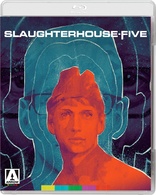
Movie rating
6.9 | / 10 |
Blu-ray rating
| Users | 0.0 | |
| Reviewer | 4.0 | |
| Overall | 4.0 |
Overview
Slaughterhouse-Five (1972)
Billy Pilgrim is an ordinary World War II soldier with one major exception: he has mysteriously become unstuck in time. Billy goes on an uncontrollable trip back and forth from his birth in New York to life on a distant planet and back again to the horrors of the 1945 fire-bombing of Dresden.
Starring: Michael Sacks, Ron Leibman, Eugene Roche, Perry King, Kevin ConwayDirector: George Roy Hill
| War | Uncertain |
| Sci-Fi | Uncertain |
| Drama | Uncertain |
| Comedy | Uncertain |
| Fantasy | Uncertain |
Specifications
Video
Video codec: MPEG-4 AVC
Video resolution: 1080p
Aspect ratio: 1.91:1
Original aspect ratio: 1.85:1
Audio
English: LPCM Mono (48kHz, 24-bit)
Subtitles
English SDH
Discs
Blu-ray Disc
Single disc (1 BD)
Playback
Region A (locked)
Review
Rating summary
| Movie | 4.0 | |
| Video | 4.5 | |
| Audio | 4.0 | |
| Extras | 4.0 | |
| Overall | 4.0 |
Slaughterhouse-Five Blu-ray Movie Review
Take 'er easy there, Pilgrim.
Reviewed by Jeffrey Kauffman November 28, 2019George Roy Hill is a perhaps curiously under recognized name in the annals of 20th century film, given the fact that he helmed two of the all time biggest hits of the sixties and seventies, Butch Cassidy and the Sundance Kid and The Sting (both probably not so coincidentally co-starring Paul Newman and Robert Redford), winning an Academy Award for directing the latter film (he received a Best Director nomination for Butch Cassidy and the Sundance Kid as well). Hill also helmed several other well remembered films, some of which at least were pretty sizable hits, including Thoroughly Modern Millie , Hawaii (one of my all time personal favorites, and I film I still have hopes will be released in high definition in its full roadshow version, quality disparities notwithstanding), The World of Henry Orient, The World According to Garp (kind of odd there are two titles in his filmography with the same opening words), and Slap Shot, among (a few) others. Hill’s output wasn’t huge by any means (the IMDb lists only fourteen feature films to his credit), but his impact would seem to be considerably larger than his remembered legacy, such as it may or may not be, might suggest. Can you think of a film that more perfectly captured the zeitgeist of 1969 than Butch Cassidy and the Sundance Kid, or another film that was as much of a sensation in 1973 as The Sting was, to cite just two examples? The legendary status of both Butch Cassidy and the Sundance Kid and The Sting may ironically have helped subsume the reputation of the film Hill made in between them, 1972's Slaughterhouse-Five, a kind of unavoidably thorny adaptation of one of Kurt Vonnegut, Jr.'s best remembered tomes. As some of the supplements on this appealing release get into, the source novel was considered "un-adaptable" by none other than William Goldman, who of course had won his own Academy Award for writing Butch Cassidy and the Sundance Kid, and for anyone who has read the original Vonnegut work, that's not hard to understand, since Vonnegut intentionally deconstructs traditional narrative approaches, offering a "timeline" that is more like a Boolean loop.
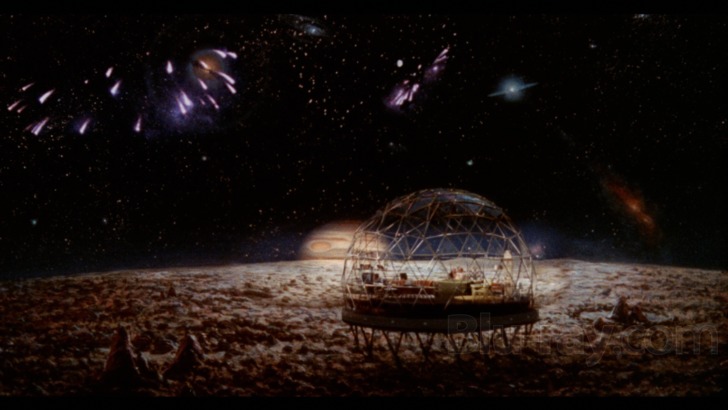
The original book version of Slaughterhouse-Five (which saliently includes the subtitle The Children’s Crusade) mined the idea of a so-called “unreliable narrator” (perhaps Vonnegut himself), but in the film probably necessarily that “meta” aspect is given over to focal character Billy Pilgrim (Michael Sacks), a man who has become (in one of the book’s more famous phrases) “unstuck in time”. That very conceit makes the film version a study in quasi-montage theory, and it’s actually kind of fascinating to see how Hill, scenarist Stephen Geller, and editor Dede Allen approach segues from era to era and locations as far flung as Dresden during the fire bombing in World War II to the alien world of Tralfamadore in an unspecified but still obviously in some sense futuristic time. A number of these transitions are rather artfully accomplished, managing to give a visual analog to Billy’s tendency to travel to and fro both spatially and temporally in times of excitement or stress.
Vonnegut’s writing had an unabashedly outré quality, albeit with an often potent metaphysical aspect, that I’m not certain any screenwriter could have adequately rendered in cinematic terms, and as such, it may be necessary to grant the film version of Slaughterhouse- Five at least a little slack, as it arguably forsakes some of the Vietnam Era antiwar subtext (though there is certainly a more general antiwar sentiment here) and simply posits Pilgrim’s “journeys” as a more or less given, without any underlying foundation ever really offered. That means there’s a perhaps appropriately post-hippie feeling that the audience just needs to “go with the flow”, much like Pilgrim himself, as the story wends its way between World War II horrors, including bullying by a sociopath named Lazzaro (Ron Liebman), to Pilgrim’s post-war domestication with wife Valencia (Sharon Gams) and (ultimately) children to what amounts to an alien abduction which deposits Pilgrim in something like a geodesic dome where he sets up shop (so to speak) with centerfold and actress Montana Wildhack (Valerie Perrine).
That short (and probably inadequate) plot summary alone may be enough to explain why Kim Newman states that Slaughterhouse-Five is the kind of film that could only be made by a director coming off a gargantuan hit who suddenly has the clout to get a big budget “art film” greenlit. Newman also mentions Robert Altman in passing in his appreciation of this film included on this disc as a supplement, and there's a certain Altman- esque quality to the proceedings here, which may at least indicate that George Roy Hill was something of a cinematic chameleon if not a perceived auteur.
Slaughterhouse-Five Blu-ray Movie, Video Quality 
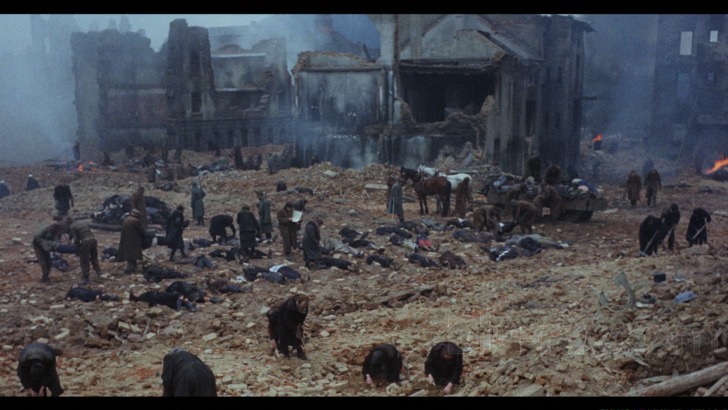
Slaughterhouse-Five is presented on Blu-ray courtesy of Arrow Video with an AVC encoded 1080p transfer in 1.91:1. Arrow's insert booklet contains the following verbiage on the restoration:
Slaughterhouse-Five has been exclusively restored by Arrow Films and is presented in its original aspect ratio of 1.85:1 [sic] with mono audio.While there's a fair degree of variability in terms of thickness of the grain field (more about that in a moment), this is a winning transfer that capably preserves the film's sometimes cool looking palette (a prevalence of grays in the World War II sequences especially are surprisingly vivid). Things are considerably warmer looking in the kind of nostalgic sequences set in Ilium where Pilgrim establishes his (Earth) family, and primaries like red pop incredibly well in these scenes. Despite the fact that the film wanders far and wide temporally and spatially, perhaps surprisingly relatively few of those transformations are accomplished via optical dissolves, and so the rather large variances in grain thickness may look uncharacteristically heterogeneous at times. A lot of the film features a really nicely resolved fine grain field, but then things can venture into noticeably more textured, almost dappled looking, territory at other times (see screenshots 3 and 19 for two examples). There aren't any really major resolution problems here, but the changes in texture are quite noticeable and may bother some viewers. The restoration gauntlet has delivered a presentation which had no major age related wear and tear that I could see.
The original 35mm camera negative was scanned in 4K resolution on a Lasergraphics Director at EFilm, Burbank.
The film was graded and restored at Pinewood Studios, London. Picture grading was completed on a DaVinci Resolve and restoration was completed using PFClean software.
Audio remastering was also completed at Pinewood.
All materials for this restoration were made available by NBC Universal.
Note: This is really a propos nothing other than my own personal curiosity, but I think this is one of the few Universal films I've ever seen that doesn't begin with some version of the "Universal globe". Instead, there's simply a text card, and I'm wondering if that's part of the "clout" Hill had at the time as referenced by Kim Newman in his analysis of the film.
Slaughterhouse-Five Blu-ray Movie, Audio Quality 
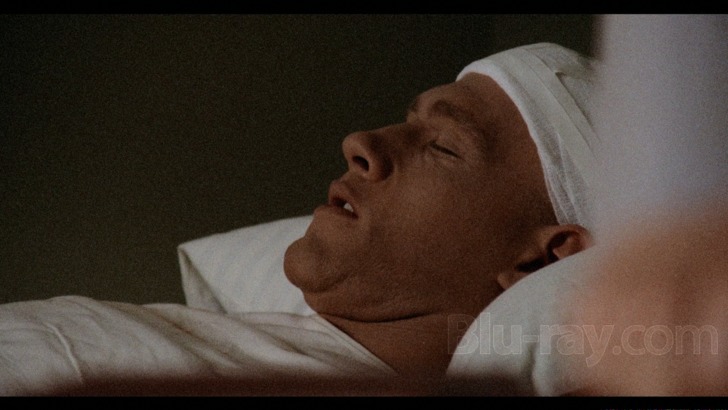
Slaughterhouse-Five features a nice sounding LPCM Mono track which offers excellent fidelity and some surprising dynamic range. The film has a rather ambitious sound design which matches the intriguing choices in segues, and the Glenn Gould performances of various Bach masterpieces sound full bodied. Dialogue and effects are rendered cleanly and clearly throughout this problem free track.
Slaughterhouse-Five Blu-ray Movie, Special Features and Extras 
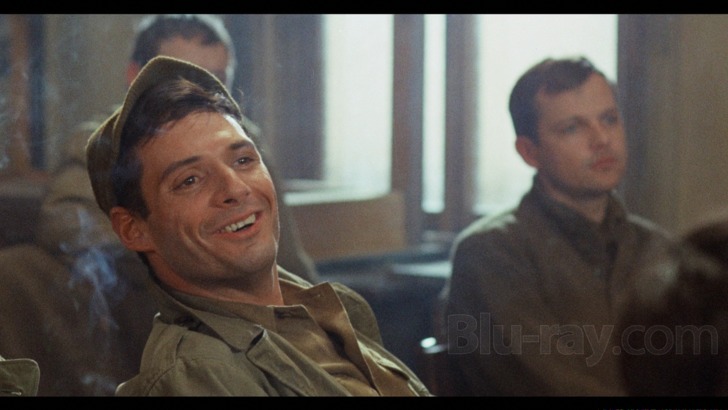
- Audio Commentary by Troy Howarth offers Howarth perhaps a bit out of his element (as even he mentions early on), with a few stumbles along the way (he calls the novel simply "Slaughterhouse" and refers to another Vonnegut offering as "God Bless You, Mrs. Rosewater".
- And So It Goes (1080p; 21:05) offers another enjoyable analysis from Newman, who manages to compare Butch Cassidy and the Sundance Kid to Jules and Jim while kind of jokingly mentioning that there's probably not going to be any "George Roy Hill as auteur" movement anytime soon on the horizon.
- Pilgrim's Progress: Playing Slaughterhouse-Five (1080p; 14:07) is an interview with actor Perry King.
- Only on Earth: Presenting Slaughterhouse-Five (1080p; 8:41) is a really interesting interview with Rocky Lang*, son of producer Jennings Lang, who discusses his father's career before, during and after the production of this film. He mentions that it seems obvious Universal didn't quite know how to market a story of a time traveling alien abductee named Pilgrim (something the film's really odd trailer confirms).
- Unstuck in Time: Documenting Slaughterhouse-Five (1080p; 14:38) is another interesting interview, with behind the scenes filmmaker Robert Crawford, Jr. discussing his efforts on the marketing side of things, after having done similar duty on Butch Cassidy and the Sundance Kid.
- Eternally Connected: Composing Slaughterhouse-Five (1080p; 11:36) features film music historian Daniel Schweiger discussing the film's interesting score that features Glenn Gould performances of classical warhorses.
- Theatrical Trailer (1080p; 4:32) is one of the longer, and patently odder, trailers that I personally remember having seen, and I'll simply ask those who watch it, "Would you have run right out to a theater to catch this film based on this?"
- Reversible Sleeve features original and newly commissioned artwork by Corey Brickley
* Note: I was pleased to offer Mr. Lang a tiny bit of help when he and his co-author Barbara Hall reached out to me a few months ago with a question about a telegram mentioning Frances Farmer that they were planning to include in their book Letters from Hollywood: Inside the World of Classic American Moviemaking. The book, which is stuffed full of "first person" correspondence from the Golden Age of Hollywood, is out now and has been getting some very appreciative reviews, for those who (as incredible as it may sound) consider media other than Blu-rays for holiday gifts.
Slaughterhouse-Five Blu-ray Movie, Overall Score and Recommendation 

Vonnegut was one of those authors du jour (kind of like Herman Hesse or Robert L. Pirsig, who wrote Zen and the Art of Motorcycle Maintenance ) who were almost de rigeur for students when I was in high school and college. If you haven't read any of Vonnegut's rather captivating books, Slaughterhouse-Five is certainly a good place to start. This film version is actually surprisingly cogent, given the source it had to adapt, and the film is filled with some fun performances, along with some rather interesting editing and production design choices. The film, much like the source novel, probably can't quite escape being something of a time capsule (which is especially ironic, given its basic conceit), and in its own way it perhaps captures the slightly confused zeitgeist of the early seventies as well as Butch Cassidy and the Sundance Kid did for the last year of the sixties. Technical merits are solid and the supplemental features very interesting, and Slaughterhouse-Five comes Highly recommended.
Similar titles
Similar titles you might also like

Seven Beauties
Pasqualino Settebellezze
1975

Counterpoint
1968

Ivan's Childhood
Ива́ново де́тство / Ivanovo detstvo
1962

La Grande Illusion
Grand Illusion
1937

The Burmese Harp 4K
ビルマの竪琴 / Biruma no tategoto
1956

The Great Dictator
1940

Stalingrad
1993

Merry Christmas Mr. Lawrence
1983

Murphy's War
1971

A Canterbury Tale
1944

Lifeboat
1944

Things to Come
1936

49th Parallel
1941

Play Dirty
1969

Kin-dza-dza!
Кин-дза-дза!
1986

To Be or Not to Be
1942

How I Won the War
1967

Come and See
Иди и смотри / Idi i smotri
1985

The Painted Bird
Nabarvené ptáce / Slipcover in Original Pressing
2019

Germany Year Zero
Germania anno zero
1948